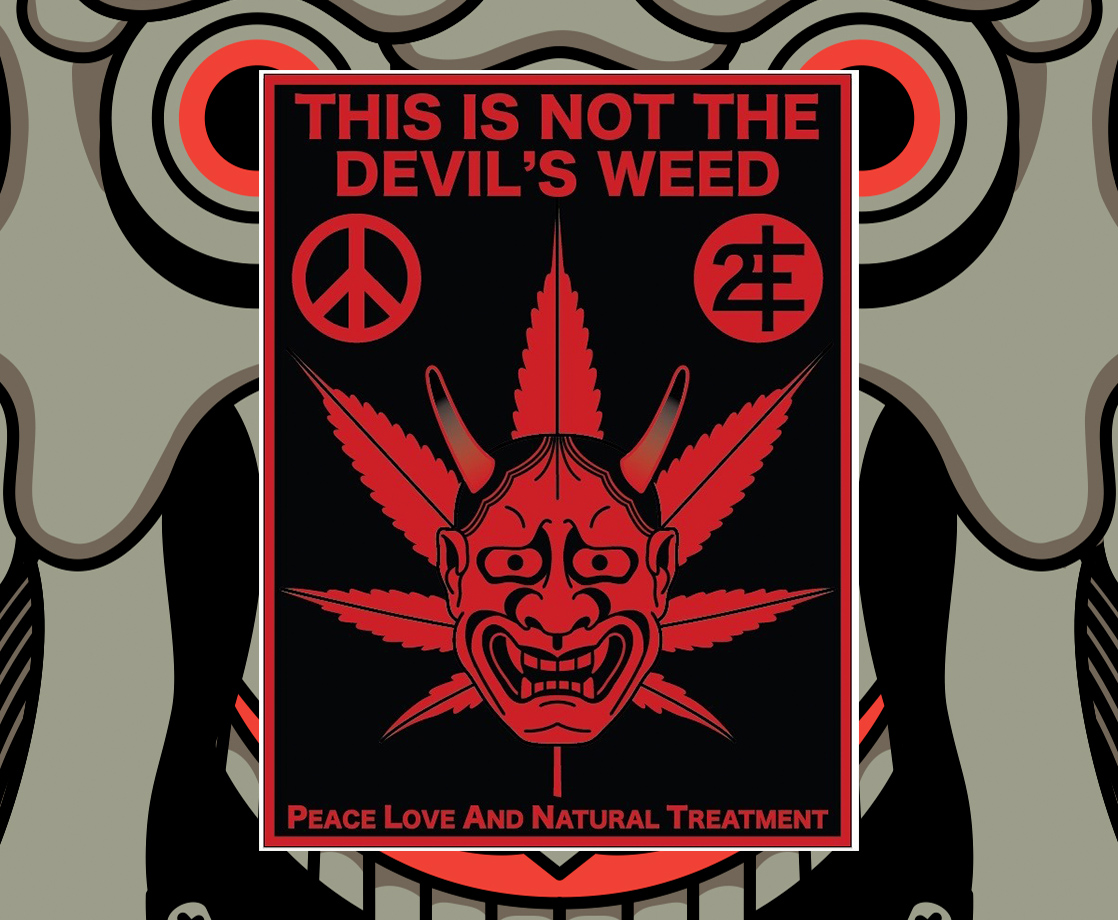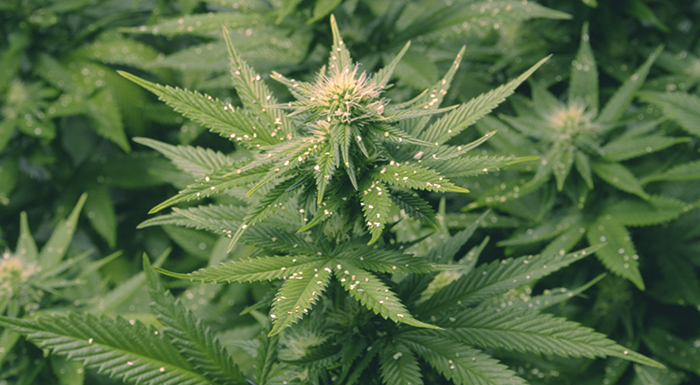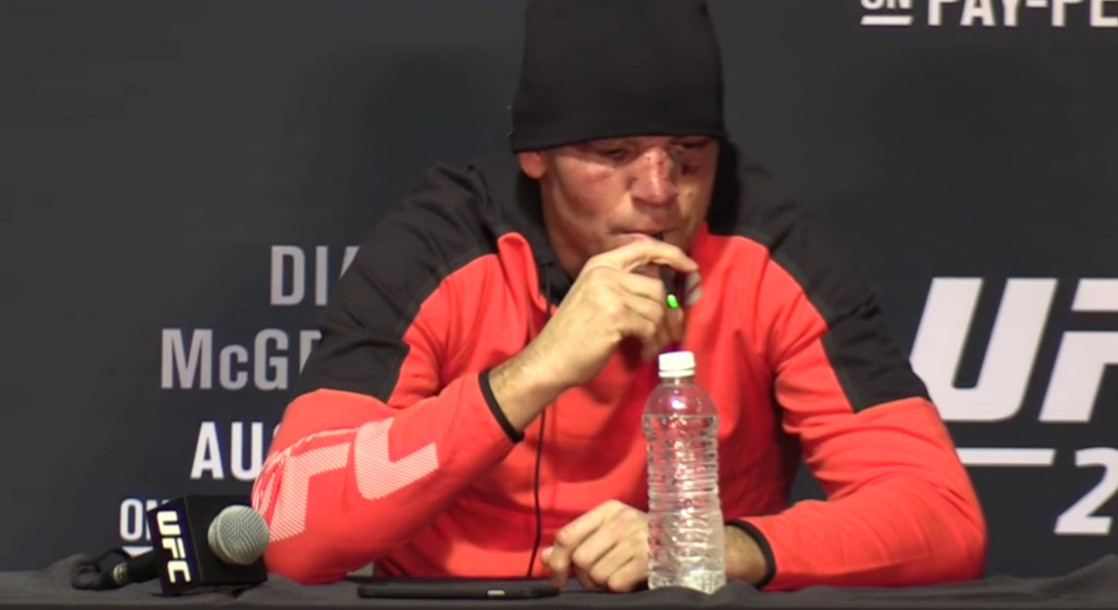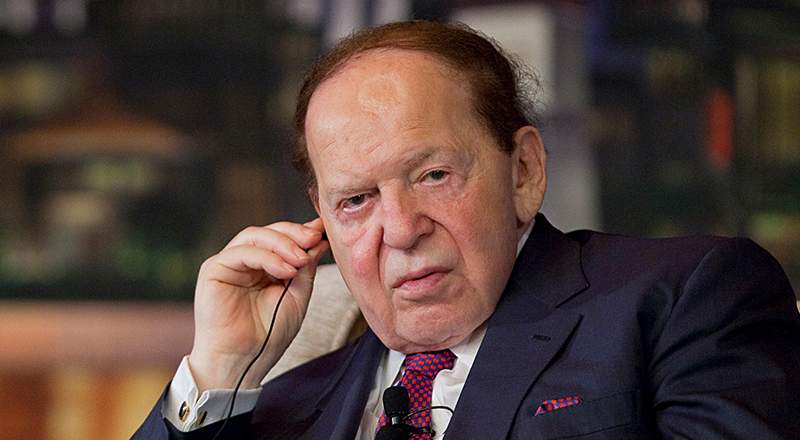All images by Alex Heir, courtesy of Sacred Bones. All photos by Zach Sokol
The artist Alex Heir starts playing a new record by Scumputer while I sit on his bed and make myself comfortable by rolling a spliff. He’s already on it though, and promptly passes a lit cannon my way. As the room fills with smoke and gabber-tinted speed punk, I notice the controlled chaos around us: there’s ephemera everywhere — a shelf full of cassettes, a wall of records, wunderkammer-like cabinets filled with pins, patches, and rare tchotchkes, framed artwork and tattoo flash (his own work, as well as friends’). The visual cornucopia is diverse and could be overwhelming, but, like Heir’s oeuvre, there’s a clear cohesiveness that permeates his Brooklyn bedroom and studio. It’s a cozy and immersive mausoleum, of sorts, though the grass admittedly enhances the vibe.
Heir’s work as an illustrator, painter, musician, and clothing designer has a cultish following, and has been (accurately) described in the past as essential in shaping “the aesthetic of contemporary underground punk.” There was a time in New York when the gig posters for any stacked line-up at DIY venues like 285 Kent or 538 Johnson came straight from his hands. The imagery blended subversive art tropes from yesteryear — rippin’ grim reapers in the vein of Pushead, macabre linework that looked like something Yoshi Toshi or Lee Brown Coye might have created if they had access to Microns, flash freak designs involving skull stabbings and anti-fascist violence — but it felt less like a retromania melting pot, and more like a torch-carrying of the creative fringe.
In 2013, Sacred Bones Records compiled Heir’s cover art, flyers, and innumerable designs into Death Is Not the End, the first book released by the label. While it served as a gorgeous documentation of his budding influence and omnipresence within certain subcultural pockets, it was a retrospective of his start as an artist, a period when he says he was still developing his voice. Now, five years later, the Bones has released Heir’s second monograph, WARRR2K∞/Work 2014-17, and the near-200 pages demonstrate that the mastermind behind Death/Traitors is more than a one-trick punk pony stuck in local-legend status.
“My work is not just one genre, you know? I don’t want to just be the skull guy or the punk flyer guy,” he tells me at one point during our lengthy and hazy conversation.

Photo by Zach Sokol
Heir has branched out since making a name for himself, not just in style but also media. The new book still features plenty of gig posters — including art for Martin Rev of Suicide, Destruction Unit, and John Carpenter, as well as his own industrial punk project L.O.T.I.O.N. — but also apparel, art objects like custom-made letter-openers, and even a motorcycle embossed with one of his distinctive skulls. Plus, it’s got paintings (new for Heir!) and the whopping anthology is in full color.
As we continued smoking spliffs and chatting over a few hours, Heir mulled on his work’s political overtones, how cannabis helps him tap into artistic alchemy, and why the gore graphics master is currently interested in painting flowers and “serene” imagery — but still in his signature style. It was the day before his 34th birthday, making it a good time to chew on the past and indulge in some self-reflection. By the time I ghoul-walked out his crib with bloodshot eyes, it was clear that the dude isn’t even close to hitting his creative peak, and the world — especially those outside dank basement venues in New York — is yet to see his magnum opus.

MERRY JANE: When was the first time you smoked weed?
Alexander Heir: I didn't actually start smoking weed until I was like 20, 21 or something. My association with weed growing up was with burnouts or hippies — shit like that. I drank and partied — it wasn't like I was straight edge — but smoking weed just wasn't where I was at, you know?
Were you still in New Jersey the first time you smoked?
No, the first time I ever smoked was in Italy. I was following a homie's band on tour and we were in this squat in Rome that looked like something out of Star Wars — like little huts built in an Ewok village. For some reason, that was the first time when I actively wanted to take a couple hits. After I did, I was just staring at this fucking brick wall for like ten hours. I loved it, though. Immediately, I thought it was so dope and was all about it.
I've noticed more pot tropes in your work lately, from the poster you designed for that concentrates company 2WENTY3, to the "Steal Your Face" imagery, to the flash tattoo designs you made for Sully Sullivan at Street Fever. Do you feel like you're actively engaging with drug-friendly imagery more than you used to?
There's a lot of stuff in the book that's very psychedelic influenced, and that's something that I've been trying to embrace a little more — referencing the feeling of being high, or highness. An actual depiction of a pot leaf is such a tired trope that you have to use it cautiously.
So like with the tattoo flash it made sense cause in the world of tattooing, it's referencing something that is cool. But for me to start bringing pot leaves into all my work, or even if I'm referencing something about drug culture or psychedelia, it can be cheap or something like that. That said, I designed this poster for a California weed brand called 2WENTY3 that makes concentrates. For them, it made sense to use overt imagery, especially because I was riffing off reefer madness stuff.

What do you think separates your new book from 2013's Death Is Not The End?
All the work in that first one was like the very beginning of my "professional" career. Making work is always a battle, regardless of how talented you are. It's a battle getting what's in your head and what's on the page to match. It's like black magic, though that's a whole other thing I could get into. A lot of the first book was just me learning how to draw, so it's the very beginning of me being comfortable with that and developing my voice.
I'm obviously still developing and learning as always, but this new book features some stuff I'm a little bit more comfortable with, and a little more comfortable playing around with, too. For example, the new one is in color, where the last one was intentionally black and white. There are full-color paintings. Now, I'm more comfortable with color, I want to use color.
So much of my stuff is very planned. I don't just start drawing, it doesn't just come like that. I find my reference drawings, I'm gridding it out, I'm laying it out, either digitally or some other way. There's a lot of pre-planning 'cause here's the thing: I'm not a great draftsman. I can't just sit down and like whip it out.

Compared to the previous book, the new one features so much more multimedia — clothing designs, album art, physical objects. Was that an intentional goal?
Yeah, it was just a progression of of what I've been able to do. Similarly to how I've been getting better at my craft with painting and drawing, I've been getting better at running a business and being able to make new, different stuff. Like I made a little knife that I sold on the Death/Traitors site. It took me like two years to make because a knife is a weapon and there are all these restrictions for selling them. It just clicked to me one day to search for letter openers and then I found something that worked. What I actually wound up doing is I got them made out of steel so you can sharpen it and make it a knife if you want.
Where does the name WARRR2K∞ come from?
There's this kinda weird poetic phrasing that I've been using with Death/Traitors, where I add three R's to "war" — kinda like drawing out war in the way war is never ending. It's not just "war" it's like "waaaaarrrr," you know? I use a lot of weird words and phrases on my shirts, so I kinda wanted to mess with that and come up with this title that's almost more a symbol itself than a word. It's 2018, but there's the infinity symbol because it's like "war, forever…"

Do you think this work is more overtly political than your past stuff?
Death/Traitors always kinda had a slight political vibe. Originally, it was on a heavy occult, secret society kinda thing. It was post-9/11 when I started it, and that was the kind of general sentiment going around. Plus, it came from a little bit more of an uneducated place. That shit became so played out itself, though.
But it started from there and I was kinda thinking more about what the brand was and what I wanted to do and what punk itself meant to me. Even just becoming more politically aware in every sense, as well as becoming an adult. That kinda honed the message of what Death/Traitors was and then I think the tie-in between those two worlds was the "You Are Your Own Master" graphic, which I felt was basically the first real Death/Traitors graphic. I had stuff for like two or three seasons before, where I was figuring out what the voice and message should be. It took a minute to tie the occult thing with images related to anarchy and politics — taking all my interests, visually and politically, and making it all cohesive.
With this new body of work, though, were you trying to make it more explicitly political, or is that just who you are now as an adult?
From the get-go, it was an element of my work. If nothing else, just identifying as a punk, identifying as anti-system — even if I didn't really know what that was — informed my stuff. As I got older and became more nuanced and started thinking about what I was actually trying to do with stuff, I thought having a [political message] was important. I've already got somewhat of a voice and this amazing propaganda tool. I'm fucking lucky enough to be like a middle class person that can actually survive off my art, so maybe I should think about other people or something.
I formulated this idea about the brand where I thought a lot about fascism and how fascism is so sexy and effective. There's this very specific aesthetic to fascism. While I find the ideology disgusting, the aestheticism is beautiful. That was the point. It's supposed to feel strong and powerful, and make those people feel that if they wear this then they're powerful, too. So my thought was, well, what if I can make another powerful visual language that looks just as badass, just as tough, just as appealing, but the message is love. It's like the same messaging, but rebranded into something else.

Were there any particular anti-fascist or anti-establishment messages that you wanted to get across?
It's interesting because like access to information is so high right now that my work — no one's art really — is going to be exposing anything, right? Like everyone knows the cops are fucked up. I don't think anyone's going to see my work and be like, "Oh wait, I never thought about that before…"
I think of it like artists should be reporting on the time they live in, the truths that they live in — be it something very personal or something more societal, which both reflect on each other. A lot of times when I'm making this work, it's just like me being in my studio and thinking about what the fuck is going on around the world kind of just reacting to it.
For example, that "NUTS" cover is in the book. I think it's one of the most successful pieces that I've ever done because it was in the wake of one of the first of many, many rounds of police killings of unarmed black men. It was during that six-month period that was just so brutal.
Thinking about that, and then the name of the magazine, and then knowing that it was gonna be mass produced and put everywhere or whatever… it just felt like police brutality was an imperative thing to talk about. And then after it was printed, I remember seeing it in a bunch of shop windows, in defiance, like: We don't agree with the cops. I was very proud of that, to see that this is something that people like hanging as a flag of resistance, you know? One store owner even had a story about some fucking beat cop, like walking around and staring at it for a while.

Your work has always also dealt with empathy, too, as punk is at its core is often about ethos and community. Do you think the work in this new book still relates to empathy?
Oh absolutely, more than ever. Even within the broad, very-flawed punk world, the overall message is like human life is valuable, you should respect other people, etc. Punks are much more empathetic than like the average Yuppie American or clean-cut suit, or whatever.
I was surprised to see you create an image of Trump because your recent work seems to clearly satirize the administration in a way where you don't have to explicitly reference it.
Listen, fuck Hillary, fuck Obama. They're all warmongers. They're all fucking capitalists. I think it's fucking stupid of Democrats to root for that. Now, I have no sympathy for neo liberal people wearing pink pussy hats. If you can't recognize that the Democrats are just as much part of the same fucked system as the Republicans…
I created the Trump image because I had a sense of urgency — just like anyone but him, you know? I couldn't bring myself to vote for Hillary, especially knowing that New York would go for her anyway. But I had an image of Hillary ready in case she won. It was the same concept as the Trump image, celebrating our newly elected president, but in real terms.
I was even vocally more disgusted with her because I didn't think Trump had a chance to win. It felt like, "Fuck these stupid liberals thinking a warmonger is going to be any better for anyone except for the upper white class." My vitriol was focused more on that, thinking that he was such a clown and wouldn't win. At that time, before he won, there was more room in the world to criticize Hillary without being a default conservative.

Were there any particular sources of inspiration that informed the work in this new book? You've mentioned Pushead and Yoshi Toshi in the past.
Definitely some cyberpunk sci-fi stuff, like the movie Tetsuo: The Iron Man, but I'm not a film guy. It's funny, I'm so hyper-picky about the music and visual art I consume. I'm taking influences, but at the end of the day I'm watching fucking Adam Sandler and like Frasier, you know?
But something that has been a huge influence on me are these Ghanaian film posters. In the '90s, there was some sort of trade agreement change or something where basically American films were coming into Ghana and they would show them at movie houses. And there were a couple different design houses that would hand paint the movie posters on rice bags. It's similar to what happened in Poland in the '80s, where the artists hadn't even seen the movie, they just had a description or something, but they'd design a poster anyway. Discovering this was huge. These posters spoke to me so much, both content-wise, and also because they paint the way I paint. Every fucking thing about it is fucking awesome.

Photo by Zach Sokol
Let's go back to cannabis for a minute. How does pot intersect with your actual creation process? Do you smoke weed while you work?
Oh non-fucking-stop. If I don't have weed, I probably can't work. I wake up and I smoke. Basically from the second I wake up, until like the second I go to sleep, I'm puffing on spliffs. You've seen the way I spliff! I like energetic sativas that are going to make you talk, and think, and not sink into the couch. That's not why I use weed, though no judgement on anyone else.
I think there's two elements to how cannabis informs my work. If we're talking about like alchemy and all that, you're taking something from the world of your mind and bringing it into the world we live in — "reality" — you're literally transcending dimensions. When I'm making something, creating is equal parts technical awareness and precision, and then equal parts conjuring this demon of creativity or inspiration or whatever it may be. So smoking helps me get into this world and tune out the other shit.
And then there's the ritual aspect, where it's like, OK, I'm going to smoke, I'm going to start this outline until I get a little bit burnt or something goes wrong or I need to wait and let the image dry… then I'll smoke a little bit again. And just take a hit. It's like almost forces you to take this break and recollect yourself.
I use weed for similar reasons. It helps me work longer, too.
Totally. It's both a moment to reflect and also like a mini-reward or something. It really helps with the conjuring process. If I'm really in the zone, it's almost this like frantic thing where I'm like drawing or painting and then I'll drink some coffee and then I'll smoke and then I'll go back to the drawing… it's this kind of whirlwind and then you just wake up and see what you've created. On one hand, you have to be hyper-aware of like your mark-making and physicality of drawing, but you also have to tune out so much of that world to get into your own zone to make shit happen.
I also think that weed and mushrooms have catalyzed the only times I could say I had any sort of real transcendent experience. It might be cliche, but it's like you can feel all those connections, you can very physically feel that anything I do reverberates throughout the universe.

What's your perspective on the War on Drugs and prohibition? Coming from someone who's lived in New York for a long time.
First of all, the War on Drugs and prohibition is all an extension of the white supremacist state. Fundamentally, I think that whatever laws help get people out of prison and help people of color and disenfranchised people so they're fucked with less should be the priority, whatever that may be. The legal pot industry wouldn't be a billion dollar industry if they just introduced it overnight. People have been smoking for years and they've been able to acquire weed because they've been getting it from other sources, not legal or corporate ones. Weed culture and today's legal industry were built on the backs of people of color, like everything else.
I worry that Phillip Morris has got fucking fields of weed, both from an anticapitalist perspective, and also from the perspective that who's to say they're not going to start putting fucking crazy shit in weed. Once the major corporations get a hold of the cannabis industry, it's going to become poisoned — like everything else. You're either for the system or against it. To them, it's like, OK if we can't send you to jail for this and make you work for us for free, then we're going to fucking mass produce weed and pump it full of chemicals and make it addictive.
Are there any subjects you want to explore with you art in the near future?
Honestly, I want to start moving away from the scary, morbid stuff. I'd love to paint, like, flowers or stuff that isn't violent. Beautiful, serene stuff, but in my style. I wonder if I let go of the hyper-violent, graphic imagery and just do some other shit, will people still react the same way? The strokes are gonna be the same, the visual language will be the same. I don't know, but there have been paintings of flowers I've seen that I'm really excited about.
Are there any other things you want to add about this book and body of work? Anything that you want people to pay attention to?
Hopefully people notice me progressing and growing. I don't think anybody really wants to be stagnant. I don't want to just be the skull guy or just like a punk flyer guy. My work is not just one genre, you know? It's like the difference between a hardcore punk band where every record's gonna sound like this one thing, or a band that might surprise you, and even can be genreless, but it's them because that's them making the music.




"WARRR2k∞ // Work 2014-2017" is out now through Sacred Bones Records — order a copy here and visit the Death/Traitors website for more of Heir's work
Follow Zach Sokol on Instagram











